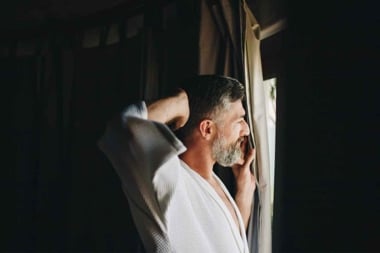A Climate Revolution

Long before she reclaimed the term “environmentalist” at 19, Wanjiku “Wawa” Gatheru spent her childhood with her elbows in the dirt, gardening alongside her mother and grandmother in Northeastern Connecticut’s Quiet Corner region. Gatheru is the child of Kenyan immigrants whose ancestry includes farmers along the maternal and paternal lines as far back as oral history reaches.
Despite an upbringing that facilitated deep connections to the land, Gatheru, who would go on to found the national nonprofit Black Girl Environmentalist (BGE), initially struggled to find her place within the environmental movement.
“I thought that being an environmentalist meant that you were really wealthy and that you went hiking and wore Patagonia—a lot of things that my family couldn't afford or activities that we weren't engaged with,” Gatheru says. “I just didn't really see my connection with the outdoors or gardening as being relevant to environmental causes.”
The real turning point in the trajectory of Gatheru’s transformation to powerhouse leader came in the form of a high school environmental science class that she wasn’t particularly excited to take. A chapter on environmental justice brought the movement much closer to home.
“That class really changed my framing around environmental issues to see that climate change was up close and personal,” Gatheru says. “I was able to better understand the ways in which the climate crisis creates new problems and intensifies all existing social ills. I realized that if I wanted to do any type of social-impact, change-making work, then I'd have to start with climate.”
Climate injustice in the Black community
Although it has been well documented that not everyone experiences climate change equally, those who endure most of the negative effects have largely been left out of the environmental movement. The research bears this out.
According to a 2018 study published in the American Journal of Public Health, Black individuals’ burden from being exposed to particulate matter—substances like soot, smoke, and dirt that can cause serious health problems when inhaledis 1.54 times higher than the general American population.
Black Americans, who comprise only 13.6 percent of the US population, are also more likely to live near coal-fired power plants, natural gas facilities, oil refineries, and fence-line communities where noise, odor, traffic, and/or emissions from commercial facilities directly impact the people who live there.
Unsurprisingly, these disparities have consequences. Black individuals have higher mortality rates due to diseases linked to environmental causes. Black women and girls are even more susceptible to negative health outcomes due to a combination of racial and gender discrimination.
“Women in general experience the brunt of the climate crisis and environmental injustice because of the ways in which the patriarchy continues to infringe on our basic rights,” Gatheru says.
“When we think about women of color,” she continues, “particularly black and Indigenous women, systemic racism, colonialism, and imperialism also have an additional impact on the ways in which our physical bodies are experiencing environmental hazards and the ways in which we have a political voice.”
At the same time, environmental science is one of the least diverse STEM fields. In 2021, 138 Black women earned degrees in environmental science, compared with 2,945 White women and 2,248 White men.
This lack of diversity is underscored by what experts call “the green ceiling,” the idea that although people of color make up nearly 40 percent of the U.S. population, they have not represented more than 16 percent of the workforce at environmental organizations.
Gatheru continues to be frustrated by these inequalities but, when she first encountered them in her teens, she felt overwhelmed. She couldn’t believe that she had stumbled on the topic of environmental justice almost by accident and that no one seemed to be talking about “the most pressing issue in the world” in a satisfactory way. Gatheru decided to do something about it.
Extreme heat and pollution in Black communities
While climate change affects all of us, the impacts are experienced differently across racial groups. Many studies have reported that Black, Latinx, Native American, Pacific Islander, and Asian communities bear the brunt of climate-related health issues.
A 2021 study from the Environmental Protection Agency found that Black and African American people are 40% more likely than their non-Black counterparts to “currently live in areas with the highest projected increases in mortality rates due to climate-driven changes in extreme temperatures.”
These individuals are also 34% more likely to “live in areas with the highest projected increases in childhood asthma diagnoses due to climate-driven changes in particulate air pollution.”
The environmental movement’s narrative problem
When she first entered the environmental movement at 15, Gatheru quickly realized that she was usually the youngest participant by at least two decades and always the only Black person. She also encountered a maddening response to her presence: people were surprised that she cared.
Gatheru felt a responsibility not only to stay in the movement—there was a clear need for younger, more diverse voices—but also to empower other people to join her. BGE was born from her commitment to change the story.
“You could Google ‘environmentalist,’ and you're not going to see someone that looks like me,” Gatheru says. “I don’t think that’s a bad thing. That is a representation of an environmentalist. But when we talk about narrative change, we're trying to make sure that there is a diverse array of representations of who an environmentalist is, what they look like, and what they do.”
BGE tackles this problem by focusing on developing a pathway for Black girls, women, and gender-expansive people to enter the climate movement and giving them a reason to stay. The organization approaches this in three distinct ways:
1. Green workforce development, which uses recruitment strategies to create a pipeline for people to enter the climate sector.
2. Community empowerment, where in-person and virtual events help attendees find their people, which further encourages them to contribute to the movement.
3. Diversity and inclusion through narrative change—an effort that inspires future activists to see themselves as environmentalists.
“My goal with BGE is to make sure that the wider environmental community recognizes that Black women and women of color have been crucial to this work for so long,” Gatheru says.
“The organization is a pathway for me to do my part to nurture the next generation of people who are very well positioned to be environmental and climate leaders, but unfortunately haven't been fully appreciated as a stakeholder group.”
Inspiring the next generation of climate leaders
BGE’s programs range from the Hazel M. Johnson Fellowship, a 10-week paid climate internship program, to the HUB program, which facilitates community-building events in 12 cities across the US.
The throughline for each initiative is the desire to foster opportunities to connect with like-minded environmentalists committed to doing the work. A bonus benefit is that young people, who are increasingly experiencing eco-anxiety related to climate change, are finding an outlet for their worries.
At HUB events, Gatheru says anyone with eco-anxiety is in good company. Being in community with others battling the same feelings can have a powerful effect.
“I would say that one of the best ways to work through climate anxiety is to recognize it and build community through action,” Gatheru says. “When we do come together and build collective power, there are opportunities for us to shift the features of our communities and have a positive impact on the future of our world.”
Make a difference with BGE
Black Girl Environmentalist (BGE) is a mostly volunteer-led nonprofit. Here are a few ways you can help make a difference:
● Financial support. The primary way to get involved with BGE is to give a recurring or one-time donation through the BGE website (blackgirlenvironmentalist.org).
● Shared resources. BGE hosts local events in donated spaces, such as coffee shops, retail stores, libraries and other community gathering places. Have a place to offer? Reach out to blackgirlenvironmentalist.org/contact.
● Become a member. Sign up for the newsletter to get updates in your inbox, and follow BGE on Instagram, TikTok, and Twitter to ensure the content reaches the right audiences. Then, spread the word!
● Foster connections. BGE is always on the lookout for allies and partners to help expand the organization’s influence and create an inclusive climate movement. Use the BGE contact link to get started.
This article was originally published in the September-October 2024 issue of alive magazine (US edition).





